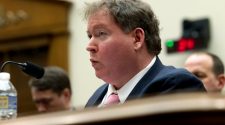But it’s a move that will have large environmental consequences and weaken former President Barack Obama’s efforts to combat the climate crisis.
The finalized rule, prepared by the Environmental Protection Agency and the Department of Transportation, was unveiled Tuesday.
The rule calls for fuel economy and emission standards to increase by 1.5% annually, rather than the approximately 5% increases in the 2012 rule. According to the rule, the standards will increase to 40.4 miles per gallon by vehicle model year 2026, about 6 miles per gallon fewer than the 2012 rule.
The administration’s original proposal would have frozen the standards.
The change “reflects the realities of today’s markets,” the administration said, such as more interest in SUVs over smaller cars and automakers’ current use of credits to meet their targets.
“Our final rule puts in place a sensible one national program that strikes the right regulatory balance that protects our environment, and sets reasonable targets for the auto industry,” EPA Administrator Andrew Wheeler said. “This rule supports our economy, and the safety of American families.”
An internal economic analysis found that while the new fuel economy standard would lower new car and truck prices, it would increase the amount consumers pay for gasoline and ultimately cost the US economy between $13 billion and $22 billion, the Times reported.
The administration said Tuesday that it believes the rule will cut the average cost of a new car by $1,000, resulting in more Americans replacing their older vehicles with newer vehicles that have more advanced safety features. That will result in fewer highway fatalities, it said.
Gina McCarthy, former EPA administrator under Obama who now heads the Natural Resources Defense Council, argued that “gutting the clean car standards makes no sense.”
“It will harm the air we breathe, stall progress in fighting the climate crisis and increase the cost of driving. The only winner from this action is the oil industry, which wants us stuck driving dirty gas guzzlers as long as possible,” McCarthy said in a statement Tuesday.
She accused the Trump administration of not focusing on the global coronavirus pandemic but rather “undermining efforts to address another major health threat.”
The rule, expected to be implemented in late spring, is likely to draw legal challenges from several states, according to the Times.
Shortly after taking office, the Trump administration had moved to reexamine those tougher Obama-era standards and end California’s authority to set tougher emissions standards than the federal standards for itself and 12 other states.
CNN’s Kevin Liptak and Chris Isidore contributed to this report.














